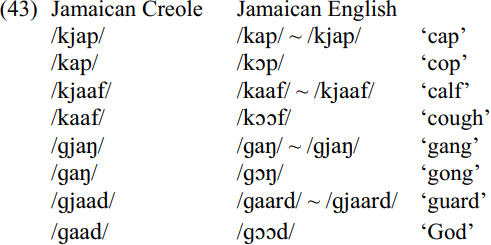

Grammar


Tenses


Present

Present Simple

Present Continuous

Present Perfect

Present Perfect Continuous


Past

Past Continuous

Past Perfect

Past Perfect Continuous

Past Simple


Future

Future Simple

Future Continuous

Future Perfect

Future Perfect Continuous

Passive and Active


Parts Of Speech


Nouns

Countable and uncountable nouns

Verbal nouns

Singular and Plural nouns

Proper nouns

Nouns gender

Nouns definition

Concrete nouns

Abstract nouns

Common nouns

Collective nouns

Definition Of Nouns


Verbs

Stative and dynamic verbs

Finite and nonfinite verbs

To be verbs

Transitive and intransitive verbs

Auxiliary verbs

Modal verbs

Regular and irregular verbs

Action verbs


Adverbs

Relative adverbs

Interrogative adverbs

Adverbs of time

Adverbs of place

Adverbs of reason

Adverbs of quantity

Adverbs of manner

Adverbs of frequency

Adverbs of affirmation


Adjectives

Quantitative adjective

Proper adjective

Possessive adjective

Numeral adjective

Interrogative adjective

Distributive adjective

Descriptive adjective

Demonstrative adjective


Pronouns

Subject pronoun

Relative pronoun

Reflexive pronoun

Reciprocal pronoun

Possessive pronoun

Personal pronoun

Interrogative pronoun

Indefinite pronoun

Emphatic pronoun

Distributive pronoun

Demonstrative pronoun


Pre Position


Preposition by function

Time preposition

Reason preposition

Possession preposition

Place preposition

Phrases preposition

Origin preposition

Measure preposition

Direction preposition

Contrast preposition

Agent preposition


Preposition by construction

Simple preposition

Phrase preposition

Double preposition

Compound preposition


Conjunctions

Subordinating conjunction

Correlative conjunction

Coordinating conjunction

Conjunctive adverbs


Interjections

Express calling interjection


Grammar Rules

Preference

Requests and offers

wishes

Be used to

Some and any

Could have done

Describing people

Giving advices

Possession

Comparative and superlative

Giving Reason

Making Suggestions

Apologizing

Forming questions

Since and for

Directions

Obligation

Adverbials

invitation

Articles

Imaginary condition

Zero conditional

First conditional

Second conditional

Third conditional

Reported speech


Linguistics

Phonetics

Phonology


Semantics


Pragmatics

Linguistics fields

Syntax

Morphology

Semantics

pragmatics

History

Writing

Grammar

Phonetics and Phonology

Semiotics


Reading Comprehension

Elementary

Intermediate

Advanced


Teaching Methods

Teaching Strategies
Palatals and labial velars
المؤلف:
Hubert Devonish and Otelemate G. Harry
المصدر:
A Handbook Of Varieties Of English Phonology
الجزء والصفحة:
473-27
2024-04-06
1153
Palatals and labial velars
The distribution of palatals and labial velars in JamE is clearly influenced by the JamC-to-JamE conversion processes which many speakers carry out. One problem converting JamC lexical inputs into an acceptable JamE realization is the fact that JamC /a/ may be realized as JamE /a/ or /ɔ/ , depending on the lexical item. There is no way, taking the JamC phonological form, /pat/, of knowing whether the JamE form should be /pat/ ‘pat’ or /pɔt/ ‘pot’. However, when JamC /a/ is part of a syllable with a palatal or labial velar stop onset, these invariably predict the correct JamE output.
Let us first take the palatals. In JamE, /kj/ and /gj/, phonetically palatal stops, [c] and [Ɉ] , have a distribution in which they vary with each other before /a/ and /aa/ but not in other environments. Thus, the item ‘cap’ has two realizations in JamE, /kap/ and /kjap/, whereas the items ‘coo’ /kuu/ and ‘queue’, /kjuu/ show a /k/ versus /kj/ phonemic contrast. The JamE /kap/ ~ /kjap/ ‘cap’ variation reflects the fact that /kj/ is part of the lexical specification of cognate items in JamC, serving to distinguish it from /kap/ ‘cop’. With the JamE pronunciation of ‘cop’ being /kɔp/, the use of /kj/ in /kjap/ has no distinctive functional value. It, however, represents a carry-over from JamC which, we argue, provides the lexical input that lies at the base of JamE phonetic output.
In the examples below, the item with /kj/ or /gj/ in the JamC item has /kj/ or /gj/ as variant forms in JamE, followed by /a/. The items which have /k/ or /g/ in the JamC item, require an invariant /k/ or /g/ in the JamE cognate and /ɔ/ as the following vowel. The weight of the phonemic distinction, transferred from the consonant in JamC to the vowel in JamE, is still expressed redundantly in the form of a residual /kj/ variant in JamE.

A very similar kind of situation applies with the labial velars, where again the presence of a semi-vowel linked feature predicts whether JamC /a/ is realized as JamE /a/ or /ɔ/ . The difference is that there are environments in which palatals occur categorically, i.e. before vowels other than /a/ and /aa/. By contrast, labial velars only occur variably in JamE, before the diphthong /ɔi/. Its JamC reflex, /ai/, is the only environment in which they may occur in JamC. In JamE, it represents a redundant feature, the labialization of /b/ in the environment of an /ai/ which has /ɔi/ as its JamE reflex. This represents independent support for the notion that the conversion process is from a JamC underlying input to JamE and not the other way around. Otherwise, we would have no way of understanding how a variable occurrence of /w/ in JamE can be converted into a categorical appearance of this form in the JamC cognates.

 الاكثر قراءة في Phonology
الاكثر قراءة في Phonology
 اخر الاخبار
اخر الاخبار
اخبار العتبة العباسية المقدسة

الآخبار الصحية















 (نوافذ).. إصدار أدبي يوثق القصص الفائزة في مسابقة الإمام العسكري (عليه السلام)
(نوافذ).. إصدار أدبي يوثق القصص الفائزة في مسابقة الإمام العسكري (عليه السلام) قسم الشؤون الفكرية يصدر مجموعة قصصية بعنوان (قلوب بلا مأوى)
قسم الشؤون الفكرية يصدر مجموعة قصصية بعنوان (قلوب بلا مأوى) قسم الشؤون الفكرية يصدر مجموعة قصصية بعنوان (قلوب بلا مأوى)
قسم الشؤون الفكرية يصدر مجموعة قصصية بعنوان (قلوب بلا مأوى)


















